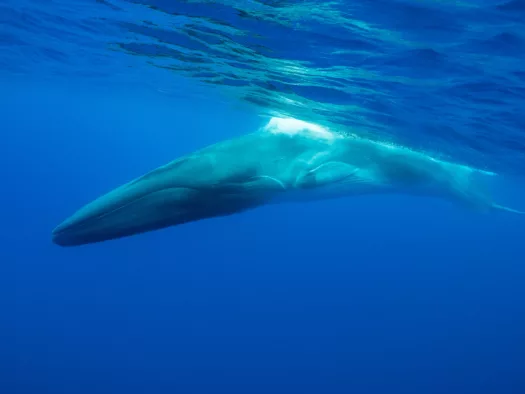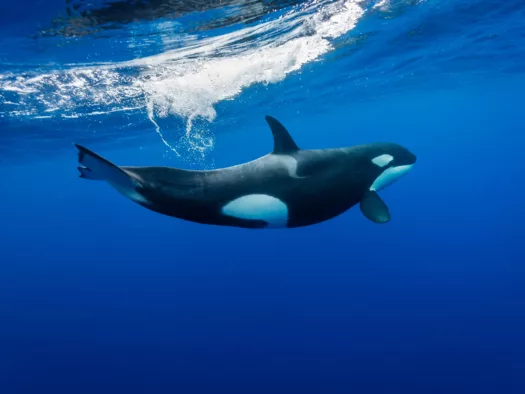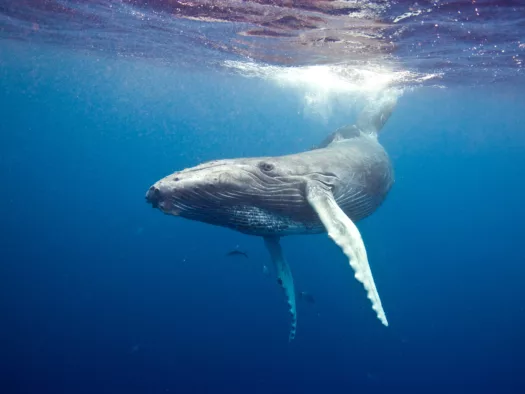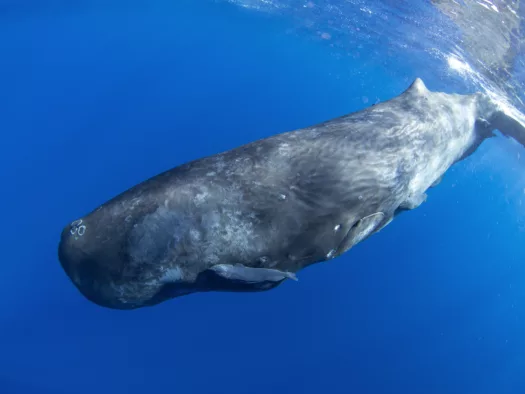
Hear the whales sing!
Whistles, clicks and very deep calls: whales communicate with each other through sounds on their journeys through the oceans. But there is a threat: underwater noise is increasing more and more. Biologists and marine researchers hold the noise of the sea responsible for marine mammals losing their orientation. Here we present a few snippets of whale talk. Listen very carefully!

The sound snippets, with the exception of fin whale calls, were recorded by PALAOA, the AWI listening station north of the German Neumayer Station in Antarctica.
The bio-duck
Antarctic minke whale
The Antarctic minke whale is the smallest baleen whale occurring in the Southern Ocean. It is regularly sighted near the sea ice edge but also occurs within the pack ice. The Antarctic minke whale produces a very unique sound called "bio-duck" which are repetitive sequences of pulsed sounds between 50 – 300 Hz with harmonics up to 1500 Hz. PALAOA records different bio-duck types during the months of June to November.

Pretty loud
Antarctic blue whale
The low frequency calls of Antarctic blue whales belong to the loudest vocalizations produced by any animal. Most likely blue whales use calls to communicate over long distances. PALAOA records different Antarctic blue whale vocalizations. The spectrogram shows the 'Z-call' which is a population-specific song produced by Antarctic blue whales in the Southern Ocean as well as on their lower latitude areas where breeding is thought to take place. Please note that we increased the frequency of the sound with 2 octaves to make the sound audible to human ears.

The one with the deep voice
Fin whale
Fin whales produce a variety of short low frequency calls, of which the 20 Hz pulse is most prominent (i.e., a downsweep ranging from around 30-15 Hz) and produced by fin whales worldwide. We record this call most frequently in the vicinity of Elephant Island, off the northern tip of the Antarctic Peninsula, where the 20 Hz pulse also often contains a higher frequency component around 89 Hz.

One whistle, one click
Killer whale
In the Southern Ocean, three killer whale ecotypes co-exist which are specialized on different prey species and vary slightly in their visual appearance. Killer whales, also called Orcas, produce a variety of vocalizations, for example whistles, pulsed calls and echolocation clicks. In the sound snippet you hear lots of calls and mainly pulsed calls.

The classic
Humpback whale
The typical whale songs which are known from various popular media, are usually produced by humpback whales. The Southern Hemisphere humpback whales spend the summer in the Southern Ocean to feed as much as possible. Reproduction and breeding mainly take place in tropical waters. At PALAOA, only humpback whale social sounds such as the ones in the spectrograms have been recorded. Humpback whale song has been found present on many of our offshore recorders along the Greenwich meridian. Ongoing research is investigating to which breeding stock these singing whales can be attributed.

High click rates
Sperm whale
Sperm whales produce a variety of clicking sounds. During foraging dives they use clicks to localize prey by emitting regular clicks and so-called creaks (short series of clicks with fast repetition rate, close to prey encounter). In social context they produce codas which are repeated patterns of clicks. Different groups of sperm whales use different codas (dialects) and within a group codas can vary slightly by individuals. At PALAOA we recorded regular click trains. In the snippet you hear several overlapping regular click trains (which are barely visible in the spectrogram) as well as some faint Weddell seal calls in the background.
